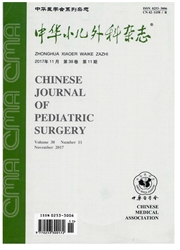

 中文摘要:
中文摘要:
目的应用跨胎盘RNA干扰技术抑制胚胎鼠骨形态发生蛋白4(BMP4)基因,为获取基因下调小鼠探索经济高效技术。方法构建发育相关基因BMP4下调质粒后通过尾静脉向孕鼠注射Ringer’s液、pSES质粒、pSESSiBMP4质粒。部分孕鼠注射48h后取出胚胎观测胚胎发育变化,并应用RT—PCR及Westernblotting检测BMP4基因mRNA和蛋白质;部分孕鼠自然分娩后研究子代鼠生长发育变化。结果在mRNA水平,pSES-SiBMP4组胚胎BMP4基因较Ringer’S组、pSES绢分别下调(29.4±5.0)%,(42.2±9.2)%(P%0.05);在蛋白质水平,pSES-SiBMP4组胚胎BMP4基因较Ringer’S组、pSES组分别下调(27.0±6.4)%、(31.1±5.8)%(P〈0.05)。pSES-SiBMP4组胚胎鼠头部、胃肠道及脊柱发育异常。新生子代鼠中pSES-SiBMP4组出现癫痫,肠息肉,先天性巨结肠。结论胚胎鼠早期跨胎盘RNA干扰现实可行,跨胎盘SiBMP4可下调子代鼠基因。该方法叮用来研究基闪功能,构建先天性巨结肠,诱导肠息肉形成。
 英文摘要:
英文摘要:
Objective To assess an economical and efficient technology to establish knock down mouse by trans-placental RNAi-BMP4 (Pxone morphogenetic protein) to mouse embryos. Methods After established BMP4 down-regulatory plasmid, the Ringer' s, pSES and pSES-SiBMP4 were delivercd to pregnant mouse via tail vein. Some embryos were taken out 48h after injection, then RT- PCR and Western blotting were used to analyze the expression of BMP4 in embryos. The growth and development of newborn mouse were observed. Results The mRNA expression of BMP4 in pSES- SiBMP4 embryo group was downregulated by (29. 4 ± 5.0) %, compared with Ringers group and by (42.2 ± 9. 2) % compared with pSES group (P〈.0.05). The protein level of BMP4 in pSES-SiBMP4 embryo group was reduced by (27. 0 ± 6. 4) % compared with Ringer's group and by (31.1 ±5.8) compared with pSES group (P-C0. 05). There was no significant malformation detected in Ringer's group or control group. In mouse embryos of pSE&SiBMP4 group, abnormalities in head, gastrointestinal tract or backbone were detected, and epilepsy,intestinal polyps and Hirschsprung were found in offsprings. Conclusions It is feasible to deliver plasmid to early staged mouse embryos, pSES- SiBMP4 can knock down BMP4 gene expression. This technique can potentially be used to evaluate gene function or to induce Hirschsprun's disease or inteslinal polyps mouse model.
 同期刊论文项目
同期刊论文项目
 同项目期刊论文
同项目期刊论文
 期刊信息
期刊信息
